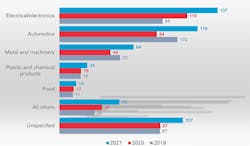Industrial Robot Installations Hit Record High
A global market summary by the International Federation of Robotics reports that 517,000 industrial robots were put in place worldwide during 2021, a +31.0% increase from 2020, and the highest number in history for that statistic. IFR also concluded that the industrial-robot segment has seen a consolidated annual growth rate of +11.0% during the five-year period concluding with 2021.
According to the summary, there are now 3.5 million industrial robots installed worldwide, +15.0% from the previous year, and completing a five-year (2016-2021) CAGR of +14.0%.
“The use of robotics and automation is growing at a breathtaking speed,” stated Marina Bill, president of the International Federation of Robotics. “Within six years, annual robot installations in factories around the world more than doubled. According to our latest statistics, installations grew strongly in 2021, although supply chain disruptions as well as different local or regional headwinds hampered production.”
Industrial robot installations grew in all geographic markets, but particularly in the Asia/Australia region where 381,000 new robots were installed. In Europe the total was 84,000, while in the Americas the total was 51,000 new robots installed during 2021.
In the U.S., new installations of industrial robots rose 14.0% year-over-year in 2021, with 34,987 put in place – “the second most successful year in history for the robotics industry in the U.S.,” according to IFR – exceeding the pre-pandemic level of 33,378 units installed in 2019.
In the United States, the automotive sector installed 9,782 industrial robots during 2021 – which was 64.0% of all the installations in North America last year. Even so, IFR reported that in past years the automotive sector has accounted for more than 70.0% of regional installations, and the decrease in the share may be attributed to U.S. automotive-sector installations, as installations in the Mexican and the Canadian automotive industries rose by 92.0% and 72.0% respectively.
Robot installations by U.S. metal/machinery manufacturing businesses increased by 66.0% year-over-year for 2021, or 3,814 units. It is the second highest sector for robot demand in the U.S., according to IFR.
The International Federation of Robotics is a non-profit trade association with about 90 members, which include national robotics associations, research-and-development institutes, robot manufacturers, and integrators. Its report, World Robotics 2022, is available for order.


